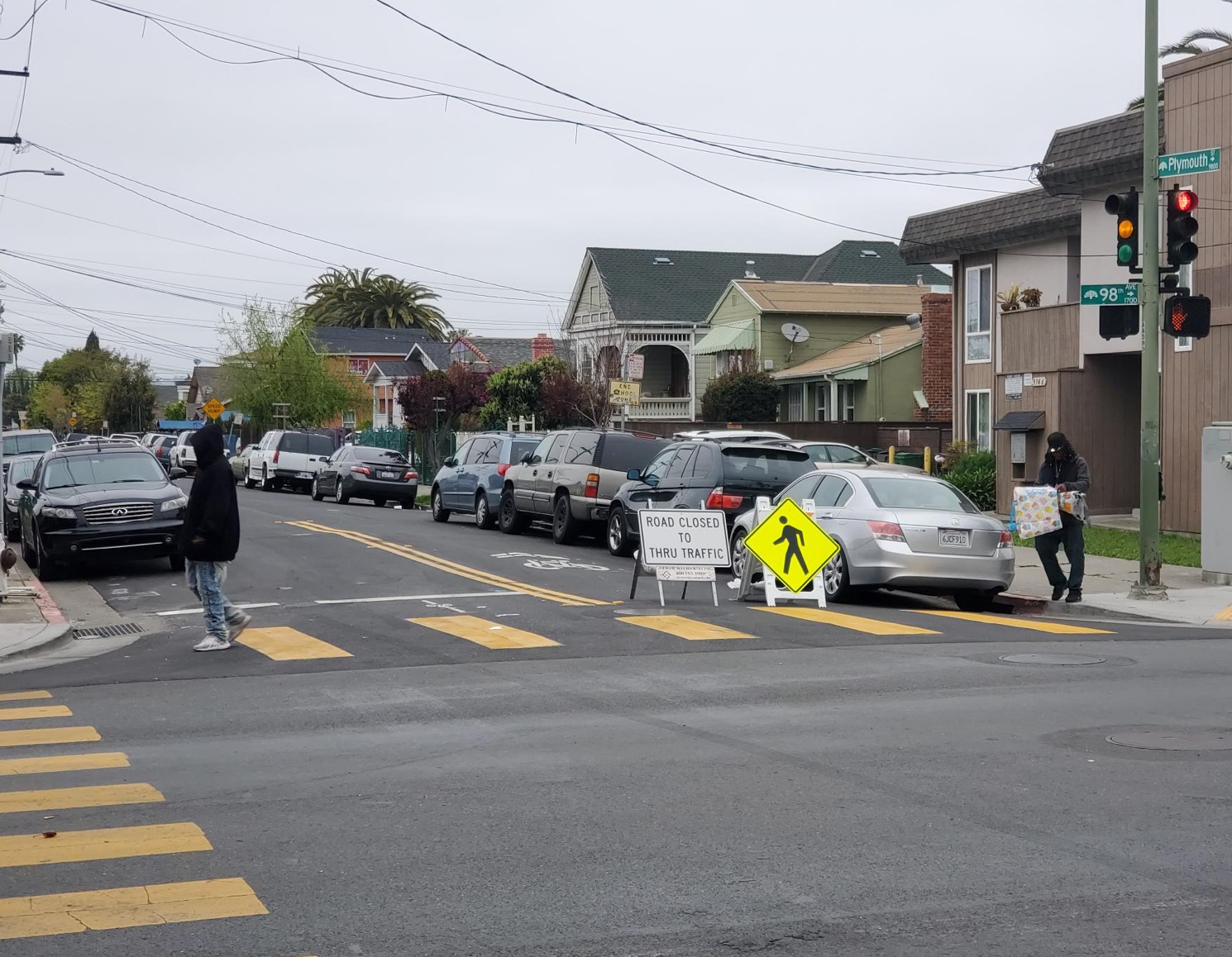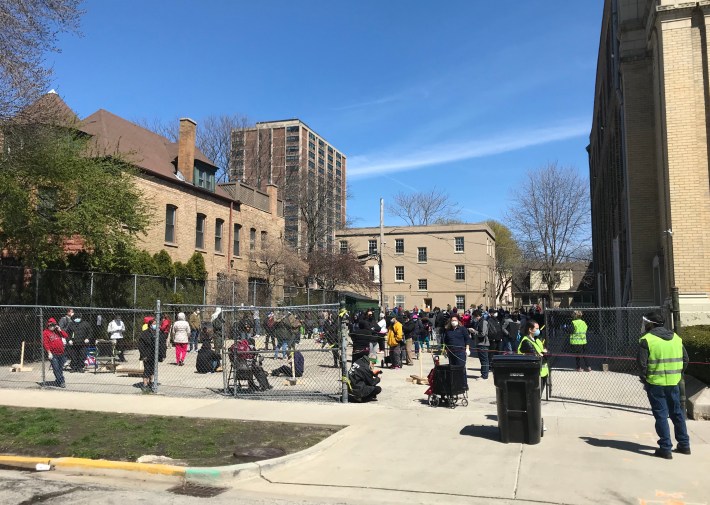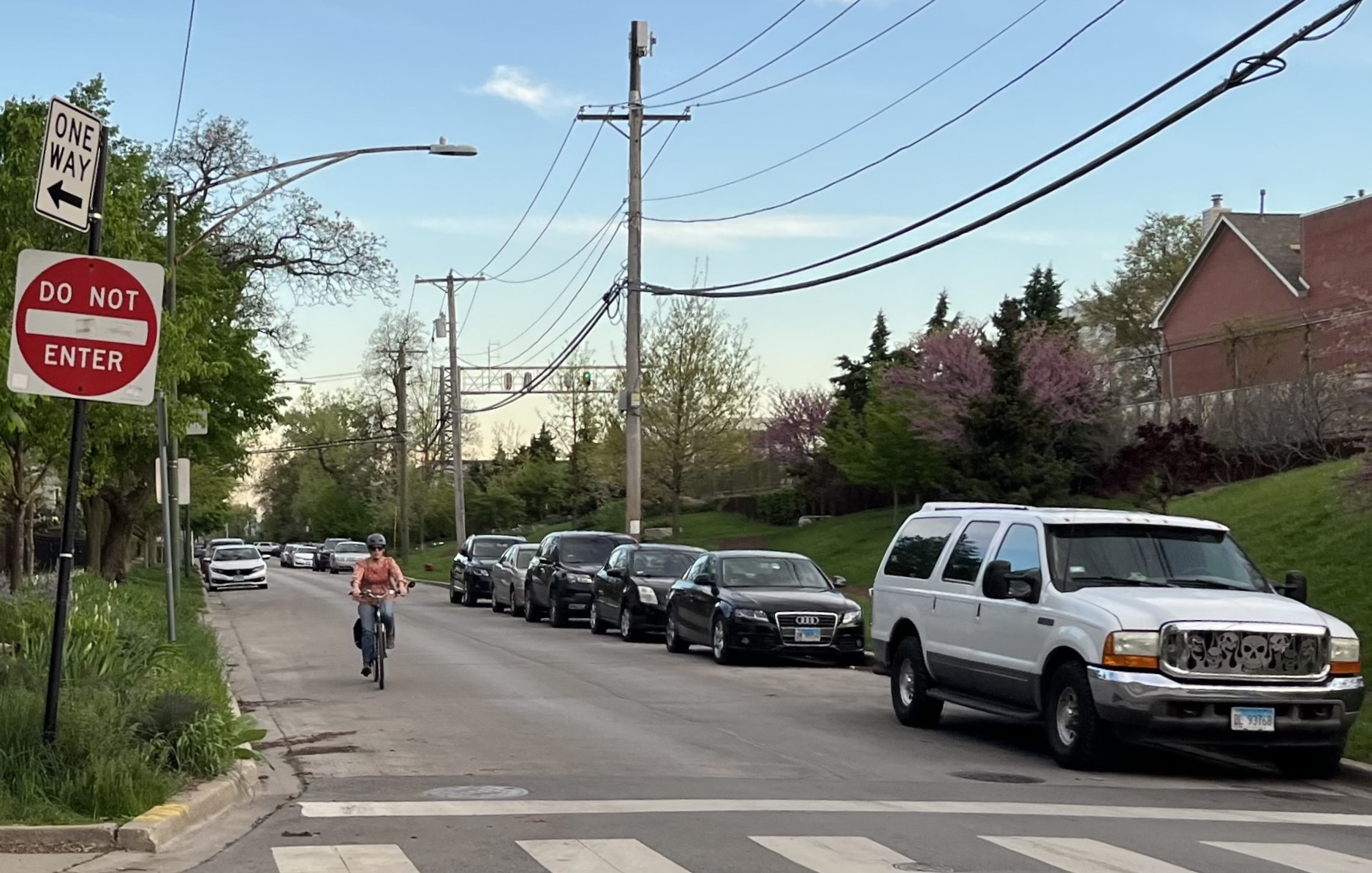A summit on open streets with Lynda Lopez, Naomi Doerner, and Ayanna Pressley
2:55 AM CDT on May 1, 2020

A Slow Street in Oakland. Photo: City of Oakland
Stay at home orders have had a striking impact on our streets. As roadways across the nation empty of automobile traffic, transit is seen as a last resort and more people are walking and biking for essential trips and exercise, a growing list of cities in the U.S. and worldwide—including New York, Boston, Minneapolis, Denver, San Francisco and Oakland —have opened streets to make room for pedestrians and cyclists to safely follow physical distancing guidelines. Chicago mayor Lori Lightfoot has not rolled out an open streets program and doesn't appear to be considering doing so any time soon. The Active Transportation Alliance, Chicago’s advocacy group for safe and sustainable transit, previously stated that establishing an Open or Slow Streets program is not a priority during the COVID-19 crisis (although today the group softened that position a bit), leading many members to ask, why not?
On Wednesday, the Cambridge, Massachusetts-based LivableStreets Alliance in partnership with WGBH Boston hosted an online forum about this very question. The second in a four-part series, “Virtual StreetTalks: Walk This Way” was billed as a discussion about the pros and cons of various street interventions, with Massachusetts Congressional representative Ayanna Pressley, a member of the influential bloc The Squad; Lynda Lopez, advocacy manager for Active Trans, and a former Streetsblog Chicago reporter; and Oakland-based Naomi Doerner, principal and director of equity, diversity and inclusion for mobility consulting group Nelson/Nygaard.

The participants didn't debate the effectiveness of Oakland’s Slow Streets program, which is prohibiting through traffic on 74 miles of side streets, versus Chicago Mayor Lori Lightfoot closing the entire lakefront to discourage crowding. Instead the conversation focused on the importance -- and challenges -- of identifying the unique problems faced by different communities and addressing them accordingly, particularly those hit hardest by COVID-19.
Stacy Thompson, executive director of LivableStreets, served as facilitator and welcomed Pressley. The congresswoman set the tone by acknowledging that low-income neighborhoods and communities of color have seen the highest COVID-19 infection and death rates, a result of health disparities that existed well before the pandemic. “It’s not surprising the highest rates of infections are within communities of color,” she said. “Latinx and African American communities are being hit hardest by this we know because of unequal access to healthcare, because of the co-morbidities of structural racism… informed by environmental injustices, transportation injustices, food injustices, housing injustices."
“While COVID-19 does not discriminate and anyone can catch it, there are communities that are more susceptible and, if [their residents] do contract it, [they] will suffer the most severe consequences," Pressley added. "It is not surprising, but it is sobering and devastating confirmation.”
Pressley pointed to her work with the newly-formed Future of Transportation Caucus, founded in partnership with Illinois Congressional rep Chuy Garcia and California rep Mark Takano, to envision a more sustainable, equitable and accessible transit system. The Fixing America’s Surface Transportation, or FAST, Act is set to expire in September and the caucus has its sights set on increased provisions in the bill for sustainable transit. “We’re making sure we see this as an opportunity to bring about structural change,” she said.

The second half of the hour was dedicated to a conversation with Lopez and Doerner specifically geared toward open streets. Though officials in their home cities have taken dramatically different stances on the issue, both advocates emphasized the importance of focusing the conversation on the most urgent needs of people in the most vulnerable situations. “We’re thinking about how we’re centering the most marginalized as we think about our streets during a pandemic,” Lopez said. “How do we center essential workers so we see them as sacred and not sacrificial?”
“The area we all agree on is that we start with problem identification: where we see the biggest issues,” Doerner said. “What we’re seeing now is that Black and Brown neighborhoods have the highest incidents of COVID infection and morbidity rates, and are the communities serving much of the essential workforce. You start with what the issue is and target solutions in that way.”
Both Nelson/Nygaard and Active Trans -- in cooperation with mobility justice collective The Untokening -- have published guidelines for how to approach the tough questions in an equitable way. Untokening’s “Mobility Justice and COVID-19” lists recommended responses to the pandemic and Nelson/Nygaard’s “Principles for Equitable Public Outreach & Engagement During COVID-19 and Beyond” provides a process-based guide to problem solving during the crisis.
Lopez noted that the problems faced by communities of color in Chicago are distinct. “Essential workers live in greater concentration on the South and West Sides,” she said. “Many workers live in low-income communities and essential jobs are disproportionately held by people of color. 70 percent of COVID deaths are Black Chicagoans.”
Lopez cited the recent demolition of Chicago's Crawford coal-fired power plant smokestack, which shrouded nearby POC communities in a cloud of irritating dust, as an example of the disparity in day-to-day problems faced by different Chicago communities. “Riding a bike in one community can mean breathing clean air in a bike lane, but in another it can mean biking next to a factory and truck traffic,” she said. “How do people experience streets differently and how does it impact how they utilize them for their needs?”
Doerner noted that Oakland's Slow Streets initiative has a phased-in rollout. "There is a focus on streets in Black and Brown communities," she said. "[The closures are] established with traffic cones and signs, so there is no [police] enforcement. The city saw speeds of vehicles increasing in corridors and thought, ‘Let’s slow the streets down and bring awareness to the fact that there are more people because of the pandemic activating the streets.’ I think these streets were already being used in the way they’re being used.”
She then reiterated the importance of understanding context. “Whether we’re talking about open streets or transit-oriented solution, what we’re saying here is it’s really important to start with the problem, who is the most affected, and how can that solution support the safe mobility of folks who do need to be out?”
A common concern for all of the participants was the future of public transit. Lopez said that Active Trans has been focusing energy on the needs of transit workers. “Getting drivers PPE, implementing free fares and rear-door boarding,” she said. “We know that some people are always going to be riding transit. We won’t transition everyone to walking or biking to work because there will always be barriers.”
Thompson also sees the role of public transit as a critical component to the conversation. “If you look out your window and see a lot of people walking and biking and think, ‘Yes! This is the future!’ It means you probably live in a pretty privileged context right now,” she said. “There are many people in the Metro Boston area who said their lives haven’t changed much—they still have to go to work and take transit. The more we can talk about transit in relation to walking and biking, the more successful we will be. Transit moves a lot of people. In cities that are opening up, car driving is going up immediately and that’s related to fear of the transit system.”
Lopez expressed the same concern about increased car traffic as the economy reopens. “We need to put our resources to figuring out how we keep people riding transit safely. And safely is key—because it’s more sustainable,” she said.
During the pandemic, many cities, from New York to Mexico City to Bogotá to Berlin, have implemented emergency bike lanes as a strategy to provide a socially-distanced alternative to riding transit. Many other cities are expanding their pedestrian and bike networks now to prevent a post-pandemic spike in driving as those who can continue to avoid transit.
There was limited time for a Q & A, but someone asked about the role of policing in open streets. “It’s partly informed my reluctance to fully embrace open streets," Lopez replied. Although the Oakland experience suggests that Slow Streets programs can be done with no additional enforcement, she argued, "It’s hard to imagine a context in which open streets would operate without policing in Chicago."
"It’s something I have a lot of concern about, how people will interact with the streets I’m advocating for," Lopez added. "It’s hard to imagine a reality where, for example, young Latino men in my community feel the liberty of embracing a street closed to cars as other people in other parts of the city would. I think that’s tied to who has the privilege of seeing the streets as theirs to reclaim."
Listen to the recording of the panel here.
Here are some tips on preventing the spread of COVID-19, and advice for Chicagoans on what to do if you think you may have been exposed to the virus.
Stay in touch
Sign up for our free newsletter
More from Streetsblog Chicago
Due to incredible support from readers like you, we’ve surpassed our 2023-24 fundraising goal
Once again, the generosity of walk/bike/transit boosters is fueling our reporting and advocacy.
Which Metra corridor would become more bike-friendly and greener under a new plan? Ravenswood!
Thanks to plans to convert little-used parking spaces, the avenue is slated to get a new bike lane, and the Winnslie Parkway path and garden will be extended south.


